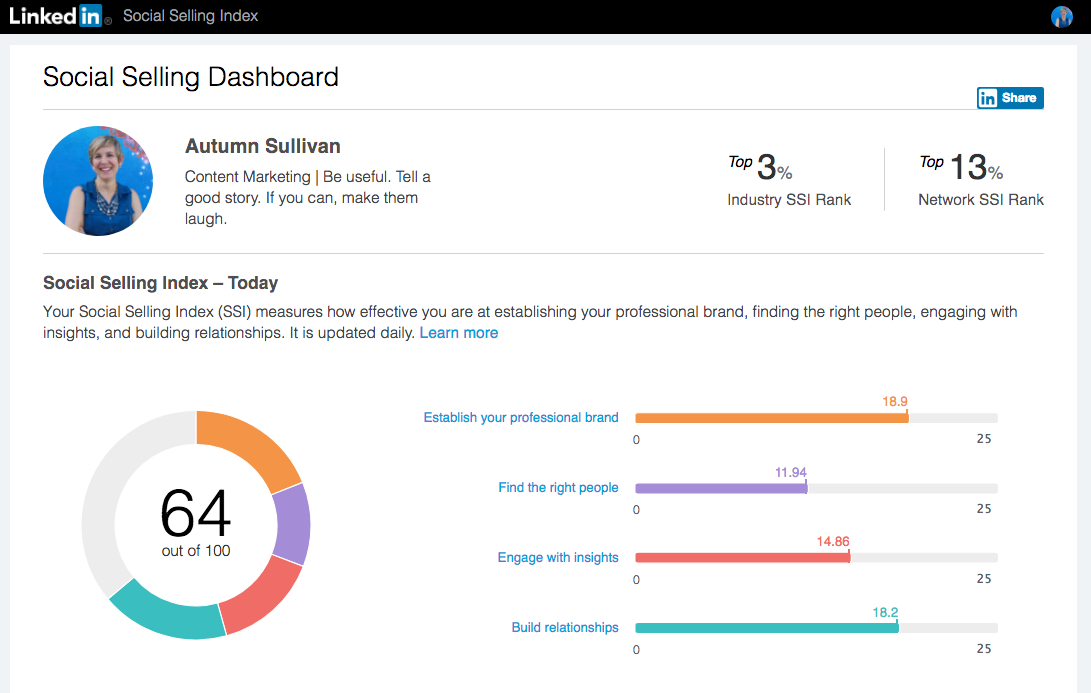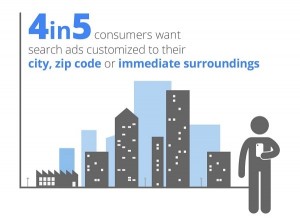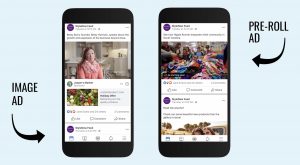— March 1, 2019
If you are using your personal LinkedIn account as part of your brand’s social selling strategy, you should keep an eye on your social selling index (SSI). And if you’re not using your personal LinkedIn account, you should be.
LinkedIn is the new popular kid
I have loved LinkedIn for over a decade. I feel like I “get” LinkedIn. For most of its existence, LinkedIn was the black sheep of the social media world. Facebook was Prom Queen, Instagram and Snapchat had full dance cards, and even Twitter had plans for Friday night — but LinkedIn sat alone in study hall.
Or maybe that was just me. Anyway …
Now LinkedIn is one of the most effective B2B Sales and Marketing channels. It’s one of the only places where people who are passionate about what they do can talk about the why, the how, and the who of their industry. It’s devoid of fluff, but not of authenticity, inspiration, and positivity.
LinkedIn is home to intelligent discourse on manufacturing, digital transformation, marketing, corporate culture, and so much more. It’s like a neverending networking event, and your SSI is a scorecard of your ability to “work the room.”
What is your Social Selling Index score?
Your SSI measures your effectiveness at using your professional brand on LinkedIn to attract leads and grow your network. It uses four pillars of measurement to produce your score:
Establishing your professional brand.
This metric is tied to your LinkedIn profile. A complete and professional profile with plenty of endorsements and recommendations is a good start. LinkedIn also looks to see how many articles you’ve published and how many followers you have.
Find the right people.
LinkedIn social selling is all about Identifying the right prospects. LinkedIn recommends using its Sales Navigator Lead Builder tool. You can also do this organically, reaching out to key decisionmakers with engaging, insightful content.
Engage with insights.
LinkedIn measures your ability to initiate and nurture relationships through your posts. It scores the number of Likes, Shares, and Comments your posts receive, as well as your incoming and outgoing Direct Messages.
Build strong relationships.
The fourth SSI pillar builds on the previous two. This measures your ability to network with influencers who can introduce you to key prospects. Metrics include your people searches, how many profiles you view, and how many days you’ve been active.
Accessing your LinkedIn Social Selling Dashboard
Curious what your LinkedIn SSI is? Finding your number couldn’t be simpler. Here’s what you need to do:
- Login to LinkedIn.
- Click this link.
Your LinkedIn Social Selling Dashboard should appear. You can see where your LinkedIn profile stands compared to the rest of your industry, as well as how you stack up against the rest of your network.

Not surprisingly, LinkedIn boosts your score if you are a Premium member and use its Sales Navigator. If I were a CMO I would certainly pony up the cost for the tool, but at $ 800 a year, this working mom ain’t got time for that.
I’ve raised my SSI to the top 4% within my industry and the top 15% within my network. I did it organically and without a paid membership. Regardless of whether you’re a paid member or not, there is plenty you can do on LinkedIn to elevate your SSI. And, your SSI is updated daily, so get ready to check-in often!
Your personal LinkedIn page is key
Your LinkedIn company page is still an important channel for sharing company news and content, but your personal LinkedIn account has a greater chance of generating a sale than your company page does.
Why? Because Sales is about relationships, and relationships happen between people.
Before you start social selling, take look at your LinkedIn page. Is it basically a glorified résumé, or is it saying something about your personal brand? Here are a few tips to get your personal LinkedIn account ready to mingle:
Profile pic. Your profile pic doesn’t have to be a professional headshot, but it should be an accurate portrayal of you as a business person. Mine is taken in front of Big Sea headquarters.
Headline. Distinguish yourself by sharing your “Why.” Big Sea’s CEO Andi Graham nails it with, ” CEO at Big Sea. Agile marketing with heart. Empathy and connection fuel growth.”
Summary. Keep this short and focused on your objective. This should be an elevator pitch, but for you as a contact, not for your product.
Experience. Simply put, nobody reads what you did at your last job, let alone a job ten years ago. (Unless they’re a recruiter.) Boil down your experience at previous organizations to a brief statement and bullet points of accomplishments.
All of these things will improve your LinkedIn SSI, setting you up for social selling success.
Using LinkedIn for account-based social selling
Now that you’re personal LinkedIn account is dressed for the party, it’s time to step out onto the dance floor and start mingling. Social selling should be part of your account-based marketing strategy.
First, create your list of target prospect companies. Identify the decision-makers you need to connect with. Click the Follow button to get their updates in your feed. What do they post, what do they comment on, what questions do they ask? Find topics where you align, and join the conversation!
If you have a connection in common, you can reach out directly, but remember: Nobody likes a cold call, even when it’s a LinkedIn direct message. Connections are fine, but you need to show interest in them as a person before you try to convert them into a lead.
Social selling and inbound marketing on LinkedIn
You can also use the insights available from your Social Selling Dashboard for a more inbound marketing strategy. This is my favorite way to connect — because all you have to do is be yourself!
Share things that you love about your role, company, and industry. Be brave and voice your opinion on issues facing your industry, talk about your core values, and tell interesting stories around your successful projects. This is not the space to be self-congratulatory; a humorous anecdote about a project is more engaging than a post filled with bragging.
LinkedIn is also measuring your article engagement. At least once a month you should post a longer piece and share it with your network. A good tip is to identify the post that received the most engagement recently and expand on that topic in an article.
Include relevant hashtags in your posts. Just like on Twitter and Instagram, hashtags on LinkedIn allow folks to easily search and curate the content that interests them. You’ll find prospects who align with your core values or share your love of some aspect of their industry.
Remember, social media is all about the conversation! Reply to comments, ask follow-up questions, Like and Share great posts from others. All of that activity improves your SSI, and more important — it’s fun!
The end result? Your posts and articles help high-quality leads who align with your approach to business find you. In a social context, they can follow you, view your profile, and even connect with you — without the fear of being pitched to immediately.
Which leads me to my final note on LinkedIn and social selling: Please don’t pitch someone who just connected with you. It’s rude.
Ready to make social selling part of your company’s strategy? Need a few pointers on polishing your profile or filling it with insights? You can always send me a note on LinkedIn, or you can contact us right here on our website.
Digital & Social Articles on Business 2 Community
(145)







